
This post originally appeared on The Consumer Goods Forum’s blog.
Over the last few years, there has been rapid growth in awareness and acknowledgment of the global food waste problem. Numerous reports and research papers provide statistics on the quantity of food – estimated at a third of what is produced for human consumption – that goes to waste each year. As a result, major food businesses and corporate interest groups (including The Consumer Goods Forum) have made commitments targeting food waste.
But moving from commitment to action can be difficult when there are alternative priorities competing for budget. Luckily, tackling wasted food can create company-wide business benefits, especially when a data-driven approach is employed. Data provides insights into why losses occur in operations, which areas provide the biggest opportunity for improvement, and how to continuously make progress towards stated goals. To capture effective data, measurement is key.
This piece provides an overview on why food waste measurement is important; tips to help measure and collect data; and how data can be leveraged to build the business case for food waste reduction initiatives. For further explanation, download Spoiler Alert’s new eBook, A Strategic Guide for Using Data to Drive Food Loss and Waste Reductions.